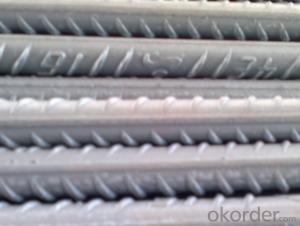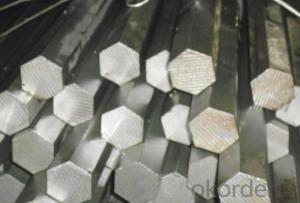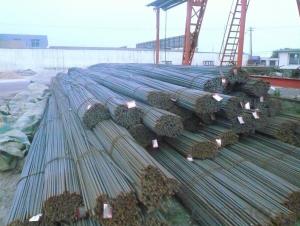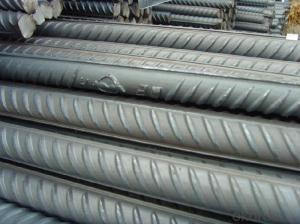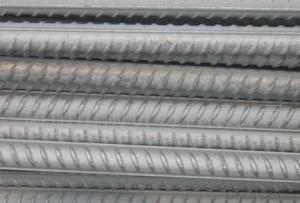Hot Rolled Deformed Steel Rebar
- Loading Port:
- China Main Port
- Payment Terms:
- TT or LC
- Min Order Qty:
- 25MT m.t.
- Supply Capability:
- 800000TONS/YEAR m.t./month
OKorder Service Pledge
OKorder Financial Service
You Might Also Like
Specifications of Hot Rolled Deformed Steel Rebar:
Standard | GB UK USA | HRB335 HRB400 HRB500 G460B, B500A, B500B,B500C GR40, GR60 | |
Diameter | 6mm,8mm,10mm,12mm,14mm,16mm,18mm,20mm, 22mm,25mm,28mm,32mm,36mm,40mm,50mm | ||
Length | 6M, 9M,12M or as required | ||
Payment term | TT or L/C | ||
Trade terms | FOB, CFR, CIF | ||
Application | Building, construction | ||
Each bundle weight | 2-3MT, or as required | ||
Type | Hot rolled steel rebar | ||
Brand name | DRAGON | ||
Theoretical weight and section area of each diameter as below for your information:
Diameter(mm) | Section area (mm²) | Mass(kg/m) | Weight of 12m (kg) | Pcs/ton |
6 | 28.27 | 0.222 | 2.664 | 375.38 |
8 | 50.27 | 0.395 | 4.74 | 210.97 |
10 | 78.54 | 0.617 | 7.404 | 135.06 |
12 | 113.1 | 0.888 | 10.656 | 93.84 |
14 | 153.9 | 1.21 | 14.52 | 68.87 |
16 | 201.1 | 1.58 | 18.96 | 52.74 |
18 | 254.5 | 2.00 | 24 | 41.67 |
20 | 314.2 | 2.47 | 29.64 | 33.74 |
22 | 380.1 | 2.98 | 35.76 | 27.96 |
25 | 490.9 | 3.85 | 46.2 | 21.65 |
28 | 615.8 | 4.83 | 57.96 | 17.25 |
32 | 804.2 | 6.31 | 75.72 | 13.21 |
36 | 1018 | 7.99 | 98.88 | 10.43 |
40 | 1257 | 9.87 | 118.44 | 8.44 |
50 | 1964 | 15.42 | 185.04 | 5.40 |
Deformed Steel Rebar in warehouse


Usage and Applications of Hot Rolled Deformed Steel Rebar:
Deformed bar is widely used in buildings, bridges, roads and other engineering construction. Big to highways, railways, bridges, culverts, tunnels, public facilities such as flood control, dam, small to housing construction, beam, column, wall and the foundation of the plate, deformed bar is an integral structure material. With the development of world economy and the vigorous development of infrastructure construction, real estate, the demand for deformed bar will be larger and larger..
Packaging & Delivery of Hot Rolled Deformed Steel Rebar:
Packaging Detail: products are packed in bundle and then shipped by container or bulk vessel, deformed bar is usually naked strapping delivery, when storing, please pay attention to moisture proof. The performance of rust will produce adverse effect.
Delivery Detail: within 45 days after received advanced payment or LC.
Label: to be specified by customer, generally, each bundle has 1-2 labels
Note:
1. Our products are produced according to national standard (GB), if not, supply according to national standards (GB) or agreement as customer required.
2. Other Grade and Standard Deformed Steel Bar we can supply:
Grade: GR40/GR60, G460B/B500A/B500B/B500C,BST500S
Standard: ASTM, BS, DIN
The Minimum Order Quantity of these products is high, and need to be confirmed.
3. We can not only supply Deformed Steel Bar; if you need anything about building materials, please contact us for further information.
4. Please send us your detail specifications when inquire. We will reply to you as soon as possible. We sincerely hope we can establish a long stable business relationship.
- Q: What is the process of installing steel rebars in concrete?
- The process of installing steel rebars in concrete involves several steps. First, the concrete surface is prepared by cleaning it from any debris or loose particles. Then, the rebars are cut, shaped, and positioned according to the structural requirements using supports or chairs to maintain proper spacing and elevation. Next, the rebars are securely tied together at the intersections using wire or mechanical connectors. After that, the rebars are placed within the concrete forms, ensuring they are adequately centered and do not touch the sides or bottom. Finally, the concrete is poured, encapsulating the rebars, and left to cure, creating a strong bond between the steel and concrete for enhanced structural integrity.
- Q: What are the common mistakes to avoid while using steel rebars?
- Some common mistakes to avoid while using steel rebars include improper placement and spacing, insufficient concrete cover, using rusty or damaged rebars, improper anchoring or tying, and neglecting to clean and prepare the rebars before installation.
- Q: Are steel rebars easy to work with?
- Steel rebars can be both easy and challenging to work with, depending on the specific task and the individual's experience and skill level. In general, steel rebars are known for their strength and durability, making them a popular choice in construction projects. They are relatively easy to handle and manipulate due to their uniform shape and standardized sizes. However, working with steel rebars also requires certain precautions and techniques. Cutting and bending rebars can be physically demanding and may require specialized tools such as rebar cutters and benders. Additionally, the weight of rebars can be a challenge, especially when dealing with longer and thicker pieces. Furthermore, proper safety measures need to be followed when working with steel rebars. Wearing protective gear, such as gloves and goggles, is crucial to prevent injuries. Attention must also be paid to avoid any potential hazards, such as sharp edges and protruding rebars. Overall, while steel rebars can be relatively easy to work with for experienced professionals, they may present challenges for individuals with limited knowledge or tools. It is recommended to seek proper training and guidance when working with steel rebars to ensure safety and achieve precise results.
- Q: What are the different types of steel rebars used in airport construction?
- To ensure the durability and structural integrity of airport infrastructure, a variety of steel rebars are utilized in airport construction. Airport construction commonly employs the following types of steel rebars: 1. Mild Steel Rebars: These rebars, made from carbon steel with a smooth surface, are the fundamental and widely used reinforcement in airport construction. They provide general reinforcement and are applicable to airport runways, taxiways, and aprons. 2. High Strength Deformed (HSD) Steel Rebars: HSD rebars undergo a heat treatment process, enhancing their strength and ductility. These rebars have ribbed surfaces that adhere better to concrete, making them ideal for critical structural elements like beams, columns, and foundations in airport construction. 3. Epoxy-Coated Rebars: For environments prone to corrosion, epoxy-coated rebars are employed. These rebars have an epoxy resin coating that shields the steel from moisture and chemicals in concrete. Epoxy-coated rebars are frequently used in airport construction, particularly in areas exposed to corrosive substances and de-icing salts. 4. Stainless Steel Rebars: Stainless steel rebars possess excellent corrosion resistance and are commonly utilized in coastal airports or high-humidity regions. They are especially suitable for reinforcing concrete structures in airport terminals, hangars, and other areas where durability and aesthetics are crucial. 5. Galvanized Rebars: Galvanized rebars are coated with a layer of zinc to protect against corrosion. They are commonly used in areas with high moisture content or where concrete is exposed to harsh weather conditions. In airport construction, galvanized rebars reinforce structures such as retaining walls, drainage systems, and other external components. 6. Welded Wire Fabric (WWF): WWF consists of parallel and perpendicular steel wires welded to form a mesh-like structure. This rebar type is employed in airport construction for concrete slabs, pavements, and large surface areas. WWF ensures uniform reinforcement and even distribution of loads across the structure. It is essential to consider specific factors such as application, structural requirements, environmental conditions, and local building codes when selecting steel rebars for airport construction. Consulting with structural engineers and construction professionals is crucial to determine the most suitable type of steel rebar for each application in airport construction projects.
- Q: What are the different types of steel rebars used in dam constructions?
- There are several different types of steel rebars used in dam constructions, each with specific properties and applications. The most commonly used types include: 1. Mild Steel Rebars: These rebars are made from low carbon steel and are widely used in dam constructions due to their affordability and availability. They provide good tensile strength, but their corrosion resistance is relatively low. 2. High Strength Deformed (HSD) Steel Rebars: HSD rebars are made from carbon steel with added alloys such as vanadium or manganese. These rebars offer higher tensile strength and better corrosion resistance compared to mild steel rebars. They are commonly used in critical areas of the dam structure that require higher strength. 3. Epoxy-Coated Rebars: To enhance corrosion resistance, rebars can be coated with epoxy. This coating acts as a barrier against moisture and chemicals, reducing the risk of corrosion. Epoxy-coated rebars are commonly used in dam constructions where exposure to harsh environmental conditions is expected. 4. Stainless Steel Rebars: Stainless steel rebars are highly resistant to corrosion and are used in dam constructions where the structure is exposed to aggressive environments, such as saltwater or chemical-laden water. They are more expensive than other types of rebars but offer superior durability. 5. Galvanized Rebars: Galvanized rebars are coated with a layer of zinc, providing excellent corrosion resistance. They are commonly used in dam constructions where the structure will be exposed to water or moisture for extended periods. The selection of the appropriate type of steel rebar for dam construction depends on factors such as the specific requirements of the project, the expected environmental conditions, and the budget. An engineering team will carefully evaluate these factors to determine the most suitable type of steel rebar to ensure the longevity and structural integrity of the dam.
- Q: What is the effect of moisture on steel rebars?
- The effect of moisture on steel rebars can be significant and can lead to various issues. Moisture can accelerate the corrosion process of steel rebars, causing them to rust and deteriorate over time. This corrosion weakens the structural integrity of the rebars and can lead to structural failures in concrete structures. When steel rebars are exposed to moisture, the water reacts with the iron in the steel, causing an electrochemical reaction known as corrosion. This reaction produces iron oxide or rust, which expands and causes the rebars to crack and spall. As the corrosion progresses, the rebars lose their strength, which can compromise the overall stability of the structure. Moisture can also contribute to the formation of carbonation in concrete, which further increases the risk of corrosion for steel rebars. Carbonation occurs when carbon dioxide from the atmosphere reacts with the calcium hydroxide in concrete, reducing the alkalinity of the concrete. This reduction in alkalinity lowers the passivation of the rebars, making them more susceptible to corrosion. In addition to corrosion, moisture can also lead to other problems such as concrete expansion, freeze-thaw damage, and efflorescence. When moisture enters the concrete and freezes, it expands, causing cracking and spalling. This freeze-thaw cycle can further accelerate the corrosion process of steel rebars. Efflorescence, on the other hand, is the crystalline deposit that forms on the surface of concrete when moisture evaporates and leaves behind salts. This white, powdery substance can degrade the appearance of concrete structures and indicate potential moisture-related issues. To mitigate the effects of moisture on steel rebars, various preventive measures can be taken. These include using corrosion-resistant rebars, applying protective coatings or membranes to the rebars, ensuring proper concrete cover over the rebars, and implementing proper drainage systems to prevent the accumulation of moisture. Regular inspections and maintenance are also crucial to identify and address any moisture-related issues before they escalate and cause structural problems.
- Q: Can steel rebars be used in earthquake-resistant construction?
- Yes, steel rebars can be used in earthquake-resistant construction. Steel rebars provide strength and reinforcement to concrete structures, making them more resistant to seismic forces during an earthquake. The ductility and flexibility of steel rebars allow them to absorb and distribute the energy generated by an earthquake, reducing the risk of structural failure and enhancing the overall resilience of the building.
- Q: What are the different methods of reinforcing concrete structures using steel rebars?
- Steel rebars can be used in several ways to reinforce concrete structures. The first method is called traditional reinforcement. This involves placing the rebars in the formwork before pouring the concrete. They are positioned in a specific pattern and secured with wire or tie rods to ensure they stay in place. This method is commonly used for reinforcing columns, beams, and slabs. Another method is pre-stressed reinforcement. This involves pre-stressing the high-strength rebars before placing them in the concrete structure. The rebars are stretched and anchored to resist the tensile forces on the structure. This method is commonly used in bridges and large-span structures that require high strength and durability. Post-tensioning is a technique used to reinforce concrete structures after the concrete has hardened. Steel tendons are inserted into pre-determined ducts or sleeves within the concrete and tension is applied using hydraulic jacks. This helps counteract the tensile forces and increase the strength and load-carrying capacity of the structure. Instead of using traditional steel rebars, fiber reinforcement involves adding small fibers made of materials like glass, polypropylene, or steel to the concrete mix. These fibers help distribute and control cracks caused by shrinkage or thermal expansion. Fiber reinforcement is often used in industrial flooring, shotcrete, and precast concrete products. Reinforced concrete masonry is another method where steel rebars are inserted into the mortar joints of concrete masonry units (CMUs). The rebars are placed vertically and horizontally at specific intervals and then grouted to ensure a solid bond between the rebars and the CMUs. In summary, these different methods of reinforcing concrete structures using steel rebars provide engineers and designers with various options to enhance strength, durability, and load-carrying capacity based on project requirements.
- Q: How do steel rebars resist fatigue and cyclic loading?
- Steel rebars resist fatigue and cyclic loading due to their high tensile strength and ductility. The presence of reinforcing bars in concrete structures helps to distribute the applied loads more effectively, preventing localized stress concentrations. The steel rebars can absorb and dissipate energy through their ability to deform elastically, which helps to withstand repeated loading cycles without failure. Additionally, the surface properties of rebars can be enhanced through various treatments, such as galvanizing or epoxy coating, which provide extra protection against corrosion and further improve their resistance to fatigue and cyclic loading.
- Q: How do steel rebars contribute to the overall resistance against natural disasters?
- Steel rebars play a vital role in increasing the overall resistance against natural disasters in various ways. To begin with, they are extensively utilized in reinforced concrete structures like buildings, bridges, and dams, which are specifically designed to endure natural disasters such as earthquakes and hurricanes. The incorporation of steel rebars amplifies the structural integrity of these concrete elements, thereby making them more capable of withstanding the forces exerted by such calamities. During earthquakes, the flexible nature of steel rebars allows them to effectively absorb and distribute the seismic energy throughout the structure. This aids in dispersing the destructive forces and diminishing the likelihood of collapse or severe damage. Moreover, the presence of steel rebars enhances the ductility of reinforced concrete structures, enabling them to deform and flex without breaking, thus enhancing their overall resilience against seismic events. In the case of hurricanes or strong winds, steel rebars offer supplementary strength and stability to concrete structures. They function as reinforcement, preventing the concrete from cracking or crumbling under the pressure of high winds. The combination of the tensile strength of steel and the compressive strength of concrete results in a sturdy and long-lasting structure that can withstand the powerful forces generated by hurricanes. Furthermore, steel rebars play a critical role in the construction of flood-resistant structures. During flooding events, the strength and corrosion resistance of steel rebars guarantee the structural integrity of buildings and other infrastructure, preventing them from suffering severe damage or being washed away. The utilization of steel rebars in flood-prone areas aids in creating resilient structures that can withstand the erosive forces of water and remain intact. Overall, steel rebars make a significant contribution to the overall resistance against natural disasters by enhancing the strength, durability, and flexibility of concrete structures. Their presence improves the structural integrity and resilience of buildings, bridges, and other infrastructure, making them more capable of enduring the destructive forces unleashed by earthquakes, hurricanes, and floods.
1. Manufacturer Overview
| Location | Hebei, China |
| Year Established | 2002 |
| Annual Output Value | Above US$ 400 Million |
| Main Markets | South Asia; Middle East;Southeast Aisa |
| Company Certifications |
2. Manufacturer Certificates
| a) Certification Name | |
| Range | |
| Reference | |
| Validity Period |
3. Manufacturer Capability
| a) Trade Capacity | |
| Nearest Port | Tianjin |
| Export Percentage | 60%-80% |
| No.of Employees in Trade Department | 11-20 People |
| Language Spoken: | English; Chinese |
| b) Factory Information | |
| Factory Size: | Above 100,000 square meters |
| No. of Production Lines | 2 |
| Contract Manufacturing | OEM service offered |
| Product Price Range | average |
Send your message to us
Hot Rolled Deformed Steel Rebar
- Loading Port:
- China Main Port
- Payment Terms:
- TT or LC
- Min Order Qty:
- 25MT m.t.
- Supply Capability:
- 800000TONS/YEAR m.t./month
OKorder Service Pledge
OKorder Financial Service
Similar products
Hot products
Hot Searches
Related keywords










